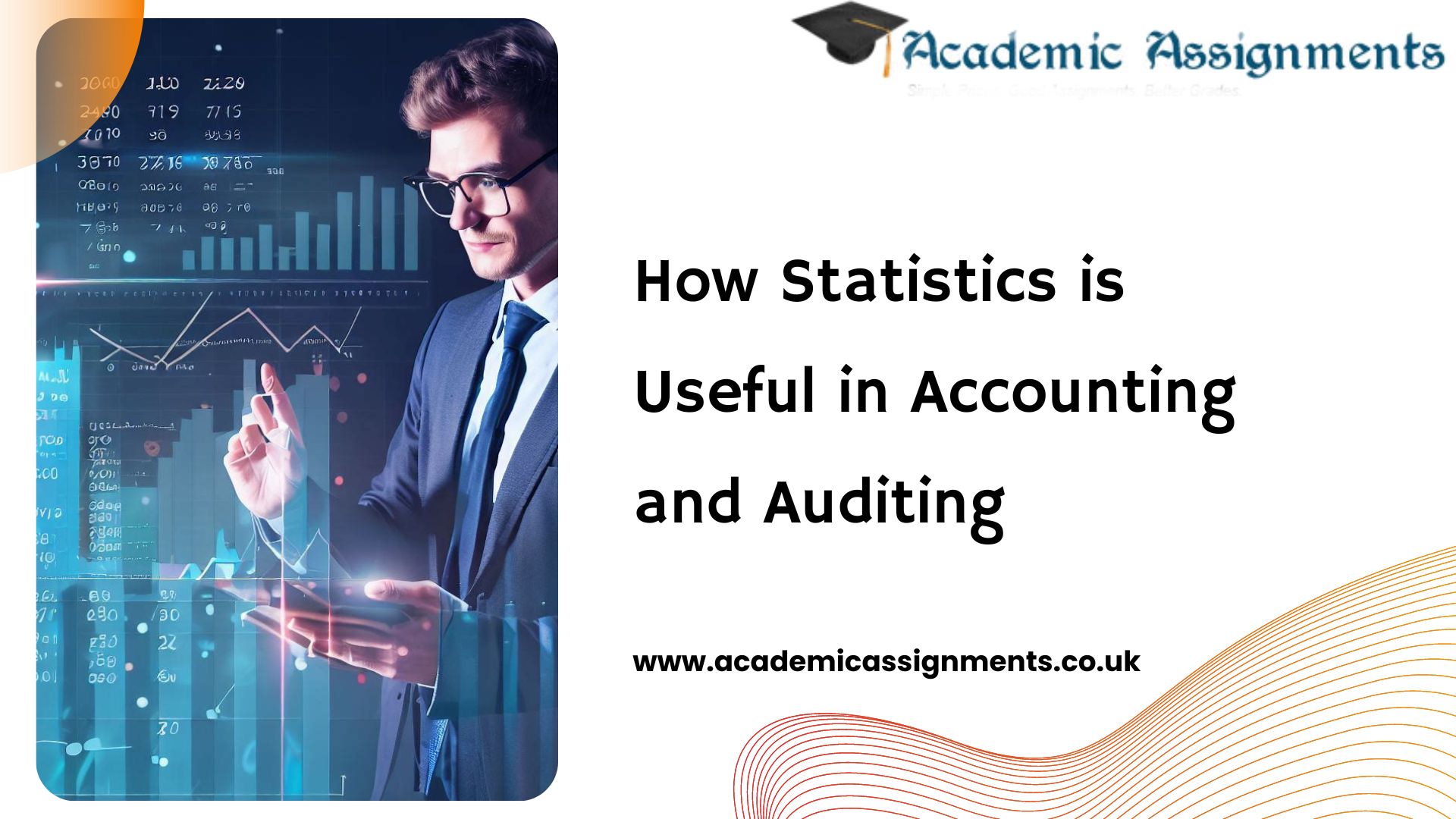How Statistics is Useful in Accounting and Auditing
Introduction
Statistics plays a significant role in collecting, analysing and interpreting data. It has multifaceted facilities, and incorporating statistical tools, theories, and techniques helps the account to interpret the data. Applying statistical approaches and formulas is the backbone of financial accounting, and it helps the account to make informed decisions.
In financial analysis, accountants usually prefer to use descriptive statistics and make a summary report of the company by collecting the expenditure, revenue and profits of a particular company. As accounting evolves with analysing the financial data and thus making a financial analysis of the company, it provides accounts with all relevant information so they can make informed decisions. In addition, accountants also keep track of financial transactions within an organisation, giving a clear picture of financial transactions. Whereas auditing refers to examining these financial data, the auditors take the responsibility of portraying accurate financial information. Thus, accounting and auditing serve as the backbone for ensuring the accuracy, transparency, and reliability of financial information. In this blog, we will reveal various usefulness of accounting and auditing and how it helps a business towards a goal. Let us save our precious time and dive into how statistics can help in accounting; before that, let’s understand the importance of accounting and auditing.
Importance of Accounting and Auditing
Accounting and auditing play a vital role in analysing the financial status of an organisation. Both the metrics are different and possess different roles; accounting encompasses a wider field where it involves everything about the cash flow of an organisation and considers all raw numbers, thus transforming them into a useful financial analysis. It enhances the accuracy of financial results by converting raw data into information and utilising information in practice. Accounting encompasses various stages and procedures performed by accountants, which involve gathering financial data, categorising them into various sections, and summarising the data. This helps to give a summary of financial transactions over an accounting year and gives a clear picture of the actual financial position of the company. This considers the accounting period’s current financial activities and transactions, and the accountants perform accounting at the end of the bookkeeping.
On the other hand, auditing refers to a sub-part of accounting. This process refers to the examination process and is performed independently to confirm that business operations follow the laws that apply to accounting principles. Audits reports of the company reflect the actual positions of the company and make fair interpretations of the financial statements. Auditing is mainly divided into two sections, that is namely internal audit and external audit. Internal audits can be defined as audits that an organisation’s employee usually performs. And on the other hand, external audits are usually performed by audit professionals, and here the company appoints the auditor. Both play a pivotal role in representing the financial position of a company.
Statistics and its Usefulness in Accounting and Auditing
As discussed above, statistics is about gathering, analysing and interpreting data. And these three factors make a huge contribution and help to make a smooth financial analysis. Statistics plays a vital role in accounting and enables accountants to look at financial data differently to make transparent explanations of financial statements. Now we will focus on how statistics can be applied to accounting. There are various reasons, and now we will go through the core reasons why statistics can be applied to accounting.
Importance of Descriptive Statistics in Accounting
One of the biggest advantages of using statistics in accounting involves helping the accountants describe the collected data and make the most out of the gathered data. Often accounting begins with evaluating a company’s revenue, expenditure and profits. These three are the vitals of any company, irrespective of their size. Whether it is a big or small company, it is independent of its size, and one has to be very much calculative with these three factors. Usually, accountants utilise this information to compare and give an insight into the organisation’s or company’s financial state. This gives a clear understanding of what position the company currently upholds and how thus they can make informed decisions or strategies based on their business goals. Thus, statistics is a useful instrument that accounts used to transform raw numbers into a meaningful financial statement involving income statement, cash flow statement, and balance sheet statement. Along with this, it helps the accountant to identify which financial parameter is affecting the financial performance, and thus this gives a clear understanding of the financial health of a company. Thus all these understanding gives a clear picture of a company’s financial stability and financial instability.
Statistical Charts and Accounting
Charts enable an accountant to get a visual representation of financial data; these play a crucial role in analysing data and give a clear understanding of data patterns. Accountants usually use line charts, scatter plots and box plots. The accountant utilises these charts to understand which financial parameters affect the financial performance over time. Accountants use line charts to represent revenue, profits, and expenditure over time visually. And further, compared with previous results, they quickly gather information on whether the company is trending up or down; based on these results, they make financial strategies depending upon the financial goals.
Budgeting and Forecasting
Accountants often use statistical approaches in making a financial budget for a company. For a fruitful financial budget to match the financial budget, accountants often use historical data on revenue, expenses and profits and make strategies that can portray accurate financial results. Budgeting will enable the company to allocate resources and funds to the required expenses, which will remain in the budget. And in addition to that, budgeting and time series forecasting will also allow the accountant to predict future values of the core factors. Various statistical models involve Monte Carlo Simulation, time series, and Linear regression analysis, which help the accounts enhance the accuracy of the financial budgeting.
Risk Assessment
In this modern era, companies have to go through various risks, and at this point, statistical tools play a crucial role and have become one of the most significant tools for accounting professionals. Risk assessment should be done before the risk becomes a major concern for the company. Risk assessment procedures will allow the accountants to evaluate and understand historical data and thus identify trends and patterns. This can be done by incorporating multi-criteria decision analysis, monte carlo analysis, covariance and beta models. Risk assessment procedure plays a crucial role in an organisation irrespective of the size of the organisation. The more efficient the process will be, the company will enhance its overall financial status.
Fraud Detection and Forensic Accounting
Statistical approaches play a crucial role in fraud detection and forensic accounting, and this approach helps organisations to identify potential fraud. Accountants often incorporate regression analysis and various detection algorithms, enabling auditors to uncover fraudulent activities by supporting legal investigations.
Performance Evaluation
Statistical approaches also help evaluate an organisation’s financial performance and thus helps them to make informed decisions. Accountants often incorporate ratio analysis, trend analysis and other statistical techniques to assess key performance indicators of a company. This gives an insight into the financial positions and helps the organisation to make decisions so that the implementation of strategies directs them towards a pre-defined goal and also makes strategies to make improvements in the areas where the company is lacking and thus optimises resource allocation.
The Usefulness of Statistics in Auditing
In auditing, statistics play a crucial role in providing insights into the financial operations of organisations. With the growing complexity of business processes and the need for accurate financial reporting, auditors increasingly rely on statistical tools and theories to enhance the effectiveness and efficiency of their audits. In this section, we will explore the usefulness of statistics in auditing and how it enables auditors to make informed decisions based on reliable data.
Data validation
Statistical tools help the auditors to validate the data and thus enhance their reliability. This process encompasses various steps, including accuracy checks, regression analysis and finding relationships between the financial parameters and thus identifying involved discrepancy that further requires investigations.
Estimation and Confidence Intervals
Auditors often need to estimate values based on the present value, and they are responsible for checking the accuracy of the data. At this stage, statistical approaches enable auditors to make informed estimates and thus construct confidence intervals. Confidence intervals can be defined as the range within which the accuracy rates fall, thus allowing auditors to identify the accuracy of the data. This is the suitable range where the auditor expects the value to fall.
Audit Sampling Technique
As the organisation involves vast data analysing every single data is quite difficult for the auditors. It enables the auditor to select the representing sample; this process does not require auditing every single transaction of the company and enables auditors to have a fruitful opinion about the company’s financial status. This technique allows an auditor to draw a conclusion based on the overall population size of the company. It also ensures that the financial records are accurate and efficient.
Conclusion
Accounting and auditing both play a pivotal role in accounting professionals. It gives a clear picture of the financial position of the company. Accounting encompasses various wider procedure, which involves gathering data, analysing, interpreting and summarising financial records of the accounting year. Whereas auditing is a sub-part of the accounting field. Both procedures are highly dependable on data. Accounting procedure converts the raw data into information, and auditing involves scrutinising the information and thus enhancing the accuracy of the information. In the modern era, accounting and auditing have empowered many organisations, irrespective of their size, enabling them to make informed decisions and thus move towards a pre-defined goal. This blog has also given a broad insight into the various uses of statistics in auditing and audits. Accounting and audits play a vital role in evaluating financial analysis, accountants utilise the revenue figure, profits, and expenditure figures and thus employ ratio analysis to make various financial projections that are namely, income statement projections, cash flow statements and balance sheets statement.
Further, it helps to identify the relationship between various financial parameters and what parameters are affecting the company’s financial performance. This is further analysed by comparing historical financial data of the company and thus identifying trends and patterns of the discrepancies. In addition, this has also explored auditing and accounting help in risk assessment by incorporating various statistical tools which involve multi-criteria decision analysis, monte carlo analysis, covariance and beta models. Statistical approaches also help in forensic and fraud detection. This can be said that auditing and accounting help enhance the company’s financial health.
Author Bio: Mark Edmonds is a highly skilled education professional specializing in statistics, accounting, and auditing. As a writer at Academic Assignments, a reputable platform offering top-quality statistics assignment help at the best price, Mark is dedicated to assisting students in achieving academic success. With his profound knowledge and expertise, he also provides exceptional accounting assignment help. Mark’s passion lies in elucidating the practical applications of statistics in accounting and auditing, making complex concepts accessible and understandable to students.

 Blogs
Blogs





